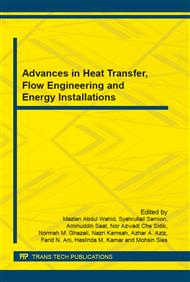p.189
p.202
p.207
p.212
p.216
p.221
p.226
p.231
p.236
Performance of Automotive Air-Conditioning System by Using Ejector as an Expansion Device
Abstract:
An automotive air conditioning system that uses thermal expansion valve (TEV) as an expansion device. The pressure drop from the condenser and evaporator pressure is considered an isenthalpic process (constant enthalpy), where this process causes energy loss (entropy generation) in the expansion process. The ejector recovers energy losses, which was previously lost in the expansion valve, and an ejector can be used to generate isentropic condition in the expansion process. The use of an ejector as an expansion device in this study can reduce power consumption of the compressor and increase cooling capacity of the evaporator. The experiments were conducted with temperature set-points of the conditioned space of 21, 22 and 23°C with internal heat loads of 100, 200 and 400 W. Measurements were taken during the one hour experimental period at a time interval of five minutes. The experiment results indicate that the ejector system is better than TEV and save fuel.
Info:
Periodical:
Pages:
216-220
Citation:
Online since:
January 2016
Price:
Сopyright:
© 2016 Trans Tech Publications Ltd. All Rights Reserved
Share:
Citation:


